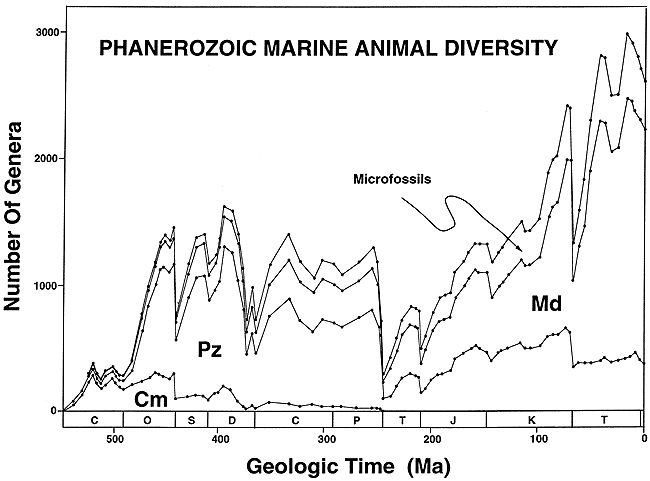Exam #1 Potential Questions
Short Answer:
- Describe two of the ways in which organisms are preserved in an altered
state. What organisms are likely to be fossilized in each of these ways?
- Apply the four preservation filters (environmental, mechanical, biological,
chemical) to each of these organisms to evaluate the preservation potential
of each. Explain your reasoning for each answer:
- What is the difference between natural selection and evolution? Be sure to define each one in your answer.
- What are the necessary conditions for natural selection to occur?
- Describe two mechanisms that can create genetic change over time without
natural selection.
- Describe at least two mechanisms by which a small amount of genetic change
could lead to a large change in the physical structure of organisms.
- Explain the difference between a biospecies and morphospecies.
- Examine the collection of fossils before you. They are all the same mophospecies.
When we call these members of the same species, what assumptions are we making?
What information do we have in defining biological species that we do not
have in defining morphological species?
- Examine the fossil lineage you have been given (to
be provided). Do you see evidence for punctuated equilibrium, phyletic gradualism,
or some combination of the two? Define the two patterns of evolution, then
cite specifically where you see either or both of them in the lineage.
- Describe at least four mechanisms of reproductive
isolation, and give an example of each.
- Under what circumstances may I choose the name of a new species? What must
I do to make that name "official"?
Essays
1. This graph shows the numbers of families (like species, genus,
family, etc) of marine invertebrates that we have measured over geologic
time.
- Does this curve accurately represent invertebrate life in the oceans over this time period?
- Explain how this record might be inaccurate. Be sure to discuss the preservation filters we talked about in class.
- Be sure to describe which organisms and environments will be underrepresented,
and which organisms and environments will be overrepresented.
- Be sure to give reasons and examples for all of your answers.

2. We are often told that the human appendix is a vestigal organ with no apparent
function. Explain the persistence of the appendix in at least three
different ways, including explanations that invoke adaptation, and those which
do NOT require natural selection. (Note: success on this question does not
require Googling to find explanations for the appendix. I do not
care whether your explanation is similar to conventional thinking about
the appendix. I want to see that you can construct explanations
that invoke adaptation, and that invoke other mechanisms, no matter how
far-fetched your explanation is. I'm trying to see if you
understand adaptation and the other mechanisms that do not depend on
adaptation).
3. One of the greatest puzzles in evolutionary biology is how complex or specialized
structures evolve, especially structures that are not functional in a simpler
form. For example, some dung beetles are camouflaged by looking like the excrement
they eat. It's hard to imagine how this trait could evolve gradually. As Stephen
Jay Gould has pointed out, there's not much adaptive advantage in looking 10%
like a turd. Describe three different mechanisms by
which this
trait could have evolved. (Again, do not spend time Googling dung
beetles. I want to see if you understand the mechanisms for the
evolution of complex structures, NOT whether you found someone elese's
ideas about dung beetles).
4. Phyletic gradualism and punctuated equilibrium represent different models
of the pace and tempo of speciation. Each model is more consistent with a particular
view of how environments change and about how speciation occurs. Explain each
model of speciation, including what it implies about environments, allopatric
and sympatric speciation.
